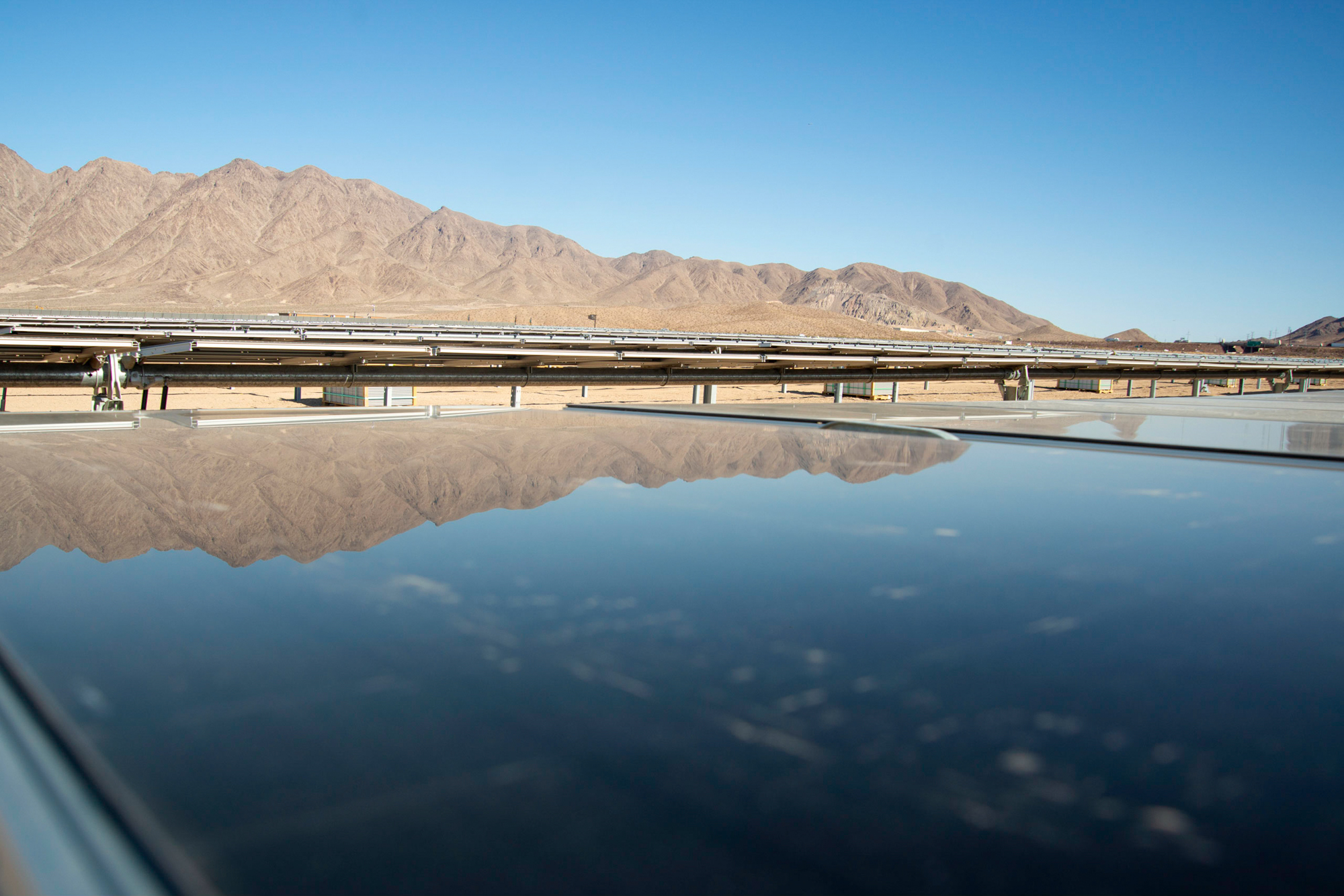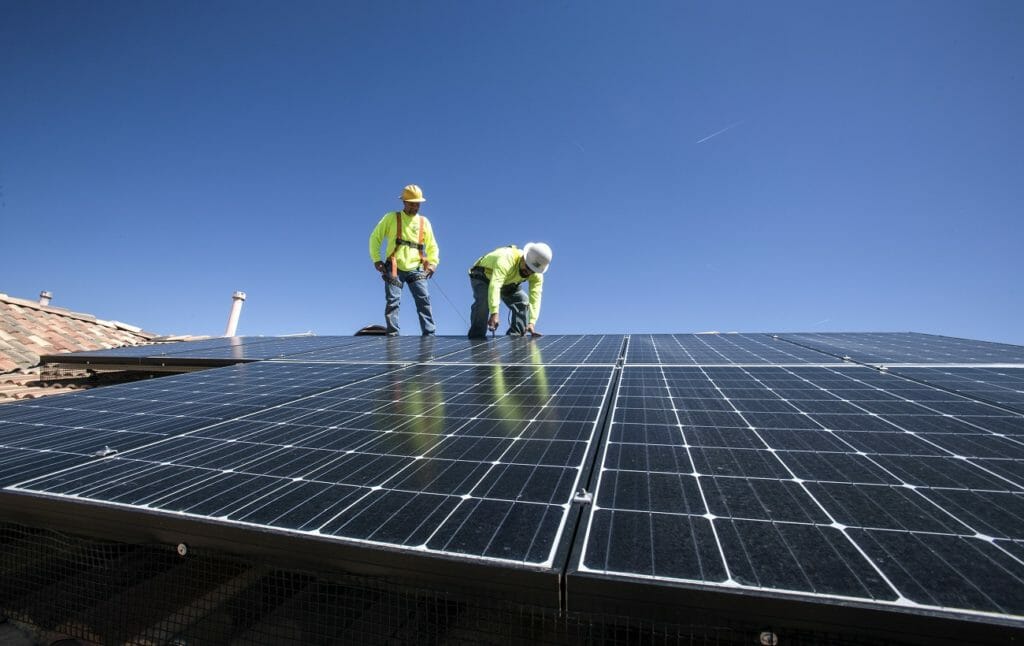For future growth, Nevada needs solar. Trump’s ‘Big Beautiful Bill’ won’t help.

Increasing power bills and significant cutbacks in Nevada’s burgeoning solar industry are among some of the consequences that clean energy experts say to expect from the recent passage of President Donald Trump’s One Big Beautiful Bill Act.
The act repeals nearly all of the estimated hundreds of billions of dollars in clean energy tax credits enacted under former President Joe Biden and rescinds any unobligated funds for clean energy and climate programs created during his presidency. Biden enacted various ambitious climate-related acts in his effort to reduce national emissions, including offering substantial tax credits on utility-scale and residential solar construction.
Although the credits were set to eventually expire, their accelerated cancellation (some as soon as this fall) could have outsized effects on Nevada, a state that leads the nation in solar generation per capita and relies on solar energy for about a third of all power produced within the state.
Clean energy advocates worry that rolling back the credits will push Nevada to rely even more heavily on imported fossil fuels such as natural gas, raising electricity bills higher in Nevada than in states that produce their own natural gas. Experts are predicting a loss of 140 gigawatts of solar production nationwide through 2035, and, as a result, the average American’s energy costs are expected to rise by about $280 over the next decade. In Nevada, experts project even larger increases, with bills rising by as much as $320 by 2035.
At the same time, the state’s demand for power isn’t slowing. NV Energy is forecasting “unprecedented load growth” in the coming decades with much of that pressure coming from industry and data centers. But if solar production slows, it could be harder to whet the state’s appetite for power given that solar is the leading power source being added to the national grid.
“In an age where we need to make it easier to build and integrate a diversity of technologies, this really shoots the country as a whole … in the foot,” said Emilie Olson, principal at Advanced Energy United, an industry association pushing for a 100 percent transition to renewable energy.

A scrambled equation
Since 2022, federal clean energy tax credits have spurred more than $15.5 billion in investment and created more than 21,000 jobs in Nevada, according to Steve Hamile, chair of the Nevada Solar Association. Nevada leads the nation with the most solar jobs per capita — for every 100,000 residents, roughly 269 are employed in a solar-related industry, such as installation, manufacturing and recycling.
Nevada ranked fourth in the nation for total electricity generation from utility- and small-scale solar resources combined last year, and there are more than 130,000 megawatts of proposed renewable energy development set to come online in Nevada through 2030. Most of that is in the form of battery storage (more than 54,000 megawatts) and solar (more than 72,000 megawatts).
Nevada currently produces about 15,000 megawatts of power annually through renewable sources, according to the Governor’s Office of Energy. One megawatt is equivalent to the power required to serve about 600 households, according to NV Energy.
Under the new law, utility-scale solar tax credits previously set to expire at the end of 2032 — as well as other credits for renewable sources such as wind — will be rolled back much sooner; now, utility-scale projects must be under construction within the next year and completed by the end of 2027 to qualify for credits.
But what it means for a project to be “under construction” is open to interpretation, leading Trump to issue an executive order outlining the details of what projects must have accomplished to qualify for the credits. That definition is expected to be released by the U.S. Treasury next month; until then, uncertainty remains, according to Hamile.
In the wake of the executive order, the Department of the Interior also announced any decisions relating to utility-scale solar projects — whether they be related to leases, biological opinions, construction or operating plans — must receive specific approval from the department.
The move “is leveling the playing field” for cost-effective and secure energy sources such as natural gas and coal, according to the department, ending “regulatory favoritism towards unreliable energy projects that are solely dependent on taxpayer subsidies and foreign-sourced equipment.”
Olson disagrees, saying the pending clarification from the Treasury combined with the Department of Interior order “really scrambles the equation” for what rollout of upcoming utility-scale solar projects looks like.
While adding additional red tape for solar and other renewable energy development, the department is streamlining processes for traditional, carbon-intensive energy sources such as coal.
Residential solar
The cuts also affect residential solar credits — they are slated to expire at the end of this year.
There are roughly 135,000 solar customers in the state, according to NV Energy; Hamile predicts there will be a rush of people trying to take advantage of the residential solar tax credits during the next several months followed by a sharp drop in sales at the start of next year. But it’s not just sales that will be affected, he said.
“It’s not only a labor-intensive business, it’s an equipment intensive business,” he said. “The ancillary support around solar companies is extensive, so the impact will be felt in a wide variety of industries.”
Combined, the state is likely to lose as many as 7,000 solar-related jobs over the next decade, according to Dan O’Brien, a senior modeling analyst at Energy Innovation, a nonpartisan energy and climate policy think tank.
Increased load forecasts
With the shortened timelines for credits, some solar and storage projects already under construction in Nevada could be completed, but dozens of others in the early stages of development face what Olson says are major hurdles. As a result, she says Nevadans will see a mismatch in energy supply and demand by the end of the decade that will consequently increase prices and see the state rely more on natural gas or other forms of imported electricity.
That mismatch will be driven in part because NV Energy’s load forecasts — the amount of power it projects that it needs to be able to supply — is expected to grow substantially over the next two decades.
The state already relies heavily on renewable resources, but that solar generation barely makes a dent in the amount of power the state uses. Nevada consumes more than 11 times the amount of energy it produces, in part because it doesn’t mine coal or produce natural gas.
The utility’s load forecasts are expected to increase about 2 percent in Southern Nevada and more than 4 percent across Northern Nevada over the next two decades, according to NV Energy’s 2024 Integrated Resource Plan.
What the utility is calling “unprecedented load growth” is primarily being driven by roughly three dozen large-scale projects across the state, including 12 data centers. The projects will need about 7,600 megawatts of additional power, with the dozen data centers requesting the bulk of that — 5,900 megawatts by 2033.
An NV Energy spokesperson said in a statement that the utility is continuing to “evaluate” federal legislation and executive orders; the company also requires new data centers to secure an energy supply commitment covering transmission and distribution costs prior to the new projects being built.
The need for more energy comes after state lawmakers effectively pushed the utility to shutter its last coal plants more than a decade ago and increased the state’s renewable energy portfolio standard, the percentage of energy that must come from renewable sources.
Utility-scale resources such as solar are attractive because of their relatively quick buildout time of just a handful of years in comparison to natural gas and geothermal plants, Olson said, pointing out that those power sources won’t be able to “scale up for near-term demand.”
That is, in part, because there is a substantial lag time in building out new gas plants because of a multiple-year backlog in turbines needed to power the plants, O’Brien said.
“Solar is the cheapest and most effective way to build energy production in Nevada. De-insentivizing the utilities from doing so is really detrimental,” O’Brien said. “What we’re seeing is in the next four or five years [is] we’re not going to be able to add in new gas plants to fill in the gap left by solar and wind.”
In February, the U.S. Energy Information Administration forecasted that 63 gigawatts of new utility-scale energy would be added to the U.S. power grid this year, but only about 4 gigawatts would be from natural gas — the rest were from wind, solar and battery storage.
O’ Brien and Olson pointed out that it is now incumbent on the state to push forward policies incentivizing renewable development.
“Nevada, despite the whims of Washington, has long decided clean energy is a bipartisan issue to get behind,” Olson said. “It’s smart finances and the state has so many resources.”
